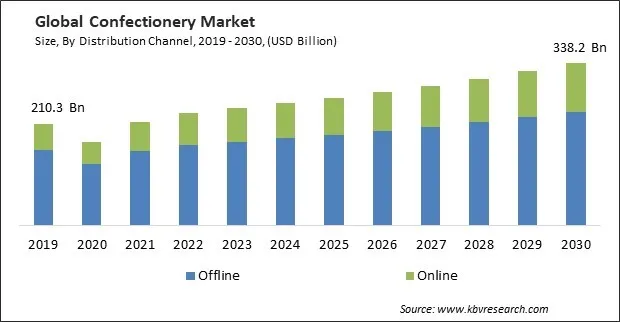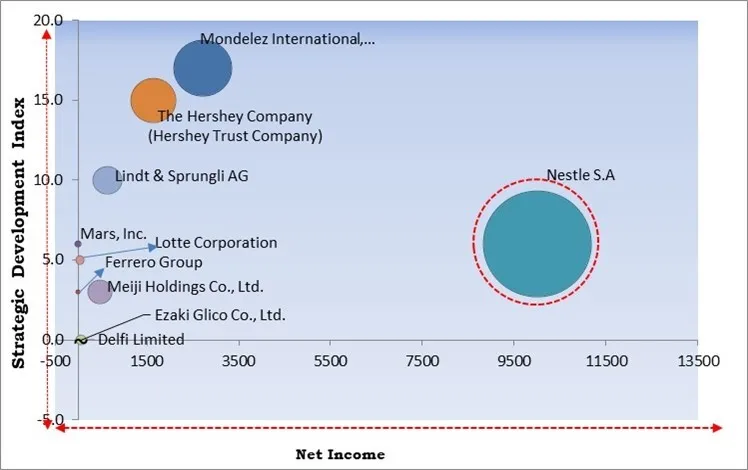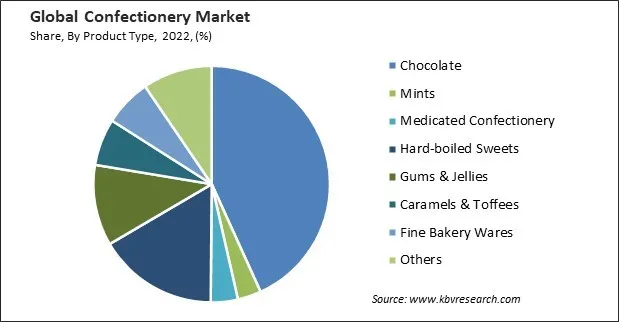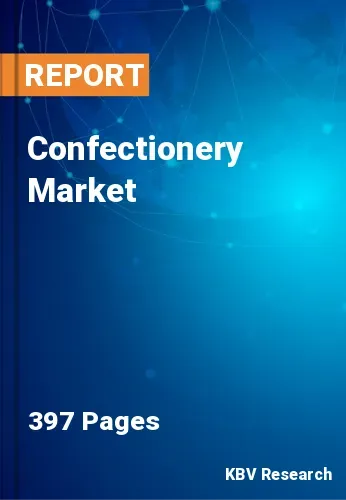The Global Confectionery Market size is expected to reach $338.2 billion by 2030, rising at a market growth of 4.8% CAGR during the forecast period. In the year 2022, the market attained a volume of 40,066.7 Kilo Tonnes experiencing a growth of 5.1% (2019-2022).
Traditional retail channels like grocery stores, gas stations, and specialty shops are vital for getting goods, but the scene has changed a lot since e-commerce became popular. Websites have made consumers' lives easier by letting them buy sweets from the comfort of their homes and have also changed how companies interact with their customers. Consequently, the online segment would account for nearly 29% of the total market share by 2030. Online platforms let companies make their marketing more specific and personalized. These include rich online experiences, social media initiatives, and influencer partnerships. These strategies help brands engage with their audience and build brand loyalty. This has made people prefer these channels over traditional channels.

The major strategies followed by the market participants are Product Launches as the key developmental strategy to keep pace with the changing demands of end users. For instance, in August, 2023, Meiji Holdings Co., Ltd. introduced cacao brand, a miscellaneous goods made with cacao husks. This launch aimed to create a system that would enrich both customers and workers in the cacao industry. Moreover, in August, 2023, Lotte India introduced coffy Bite, the coffe-toffe brand. The launched product aimed integration of nostalgia by innovatively fusing rich coffee and creamy vanilla.
Based on the Analysis presented in the KBV Cardinal matrix; Nestle S.A is the major forerunner in the Market. In January, 2022, Nestle released Aero Melts buttons and Kit Kat Bites, a line of new products for the spring. With this launch, the company aimed to pull out the stops for the Easter season, which is one of the most lucrative prospects for the market players operating in the confectionery sector. Companies such as Mondelez International, Inc., The Hershey Company (Hershey Trust Company) and Lindt & Sprungli AG are some of the key innovators in the Market.

The surge in demand for sugar-free confections has sparked a significant shift within the market. This trend has prompted manufacturers to innovate and diversify their product lines, introducing a broader array of sugar-free options. Furthermore, the escalation in demand for sugar-free confections has bolstered research and development efforts within the industry. Manufacturers invest in innovative technologies and explore alternative sweetening agents to enhance taste profiles while maintaining sugar-free or reduced-sugar formulations. Thus, the burgeoning demand for sugar-free confections has transformed consumer choices and spurred innovation and progress within the market.
The market is helped by how different retail platforms work together to meet the needs and shopping habits of a wide range of customers. Traditional retail channels like grocery stores, gas stations, and specialty shops are still vital for getting goods, but the scene has changed a lot since e-commerce became popular. Since more people are shopping online, companies can get more information about their customers. This lets them make their marketing more specific and personalized. Therefore, the expansion of retail channels positively affects the market's growth.
Cocoa and sugar are two essential ingredients used to make confectioneries worldwide. In the past few years, sugar and cocoa prices have increased because of how quickly their manufacturing and consumer demand changes on the market. The natural ingredients used to make sugar candies come from several different places. R&D costs are high, and the prices of raw materials change all the time. This will slow the growth rate of the market. These regular fluctuations in the prices and demand of raw materials subsequently affect the products' production and sales in the market.
Based on product type, the market is fragmented into chocolate, mints, hard-boiled sweets, caramels & toffees, gums & jellies, medicated confectionery, fine bakery wares, and others. The hard-boiled sweets segment attained a significant revenue share in the market in 2022. Some sugar-based syrups, such as Mylose and Glucomalt, are cooked in a range of temperatures from 302 to 356 °F to make hard-boiled sweets. Hard-boiled sugary treats include aniseed twists, Bêtises de Cambrai, stick candies, and lollipops. Across the world, kids love hard boiled sweets in massive amounts.

By distribution channel, the market is bifurcated into offline and online. The online segment garnered a considerable growth rate in the market in 2022. The advantage of online platforms is the ability to shop from any location and at any time. Consumers have the ability to peruse an extensive assortment of these items, place orders, and have the items conveniently transported to their residences, thereby obviating the necessity to visit brick-and-mortar establishments. Some online platforms offer subscription services or easy reordering options, allowing customers to set up regular deliveries of their favorite items without the hassle of repeatedly making purchases.
| Report Attribute | Details |
|---|---|
| Market size value in 2022 | USD 233.7 Billion |
| Market size forecast in 2030 | USD 338.2 Billion |
| Base Year | 2022 |
| Historical Period | 2019 to 2021 |
| Forecast Period | 2023 to 2030 |
| Revenue Growth Rate | CAGR of 4.8% from 2023 to 2030 |
| Number of Pages | 397 |
| Number of Table | 773 |
| Quantitative Data | Volume in Kilo Tonnes, Revenue in USD Billion, and CAGR from 2019 to 2030 |
| Report coverage | Market Trends, Revenue Estimation and Forecast, Segmentation Analysis, Regional and Country Breakdown, Competitive Landscape, Porter’s 5 Forces Analysis, Company Profiling, Companies Strategic Developments, SWOT Analysis, Winning Imperatives |
| Segments covered | Product Type, Distribution Channel, Region |
| Country scope |
|
| Companies Included | Mars, Inc., Nestle S.A, Mondelez International, Inc., Ferrero Group, Lindt & Sprungli AG, The Hershey Company (Hershey Trust Company), Meiji Holdings Co., Ltd., Lotte Corporation, Delfi Limited and Ezaki Glico Co., Ltd |
| Growth Drivers |
|
| Restraints |
|
Based on region, the market is analyzed across North America, Europe, Asia Pacific, and LAMEA. In 2022, Europe region acquired the largest revenue share in the market. Europe has a significant demand for chocolate candies because more and more chocolates are being made there. The countries that produce and eat the most chocolate in Europe are Switzerland, Germany, Belgium, Austria, and the UK. Upcycling is a growing trend in the European candy industry, where treats are made of various items. Producers see this in the market as an opportunity to add value to waste materials or leftovers that would otherwise go to waste.
Free Valuable Insights: Global Confectionery Market size to reach USD 338.2 Billion by 2030
The market research report covers the analysis of key stake holders of the market. Key companies profiled in the report include Mars, Inc., Nestle S.A, Mondelez International, Inc., Ferrero Group, Lindt & Sprungli AG, The Hershey Company (Hershey Trust Company), Meiji Holdings Co., Ltd., Lotte Corporation, Delfi Limited and Ezaki Glico Co., Ltd
By Distribution Channel (Volume, Kilo Tonnes, Revenue, USD Billion/Million, 2019-30)
By Product Type (Volume, Kilo Tonnes, Revenue, USD Billion/Million, 2019-30)
By Geography (Volume, Kilo Tonnes, Revenue, USD Billion/Million, 2019-30)


This Market size is expected to reach $338.2 billion by 2030.
Increasing demand for sugar-free chocolates are driving the Market in coming years, however, Fluctuations in the price of raw materials restraints the growth of the Market.
Mars, Inc., Nestle S.A, Mondelez International, Inc., Ferrero Group, Lindt & Sprungli AG, The Hershey Company (Hershey Trust Company), Meiji Holdings Co., Ltd., Lotte Corporation, Delfi Limited and Ezaki Glico Co., Ltd
In the year 2022, the market attained a volume of 40,066.7 Kilo Tonnes experiencing a growth of 5.1% (2019-2022).
The Offline segment led the Market, by Distribution Channel in 2022; thereby, achieving a market value of $240.8 billion by 2030.
The Europe region dominated the Market, by Region in 2022, and would continue to be a dominant market till 2030; thereby, achieving a market value of $117.1 billion by 2030.
Our team of dedicated experts can provide you with attractive expansion opportunities for your business.

